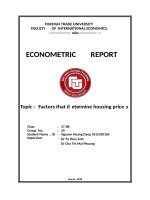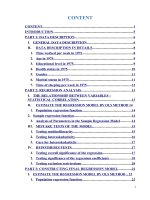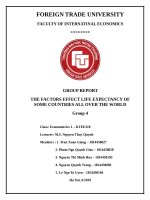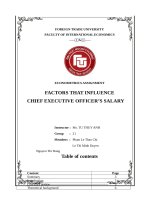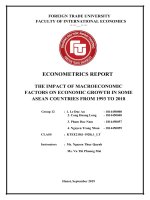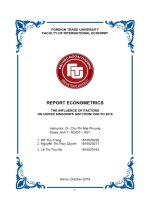tiểu luận kinh tế lượng ECONOMETRICS REPORT factors affect students’ GPA
Bạn đang xem bản rút gọn của tài liệu. Xem và tải ngay bản đầy đủ của tài liệu tại đây (2.77 MB, 30 trang )
ECONOMETRICS REPORT
Class: KTEE309.2
Instructor: PhD. Dinh Thi Thanh Binh
ABOUT US
Nguyễn Nam Anh - 1811150046
Vũ Tuấn Đức - 1810150006
Nguyễn Mạnh Hùng - 1811150083
OUR TOPIC
FACTORS THAT AFFECT
STUDENTS’ GPA
Phạm Văn Trọng - 1811150138
AN VAN CHAT LUONG download : add
TABLES OF CONTENT
I, Introduction .............................................................................................................3
II, Literature review ....................................................................................................4
1. Question of interest ..................................................................................................4
2. Some background analysis into the topic.................................................................4
3. Methodology.............................................................................................................6
4. Procedure and program used....................................................................................6
III. Economic model....................................................................................................8
1. Specifying the object for modeling ..........................................................................8
2. Defining the target for modeling by the choice of the variables to analyze, denote {xi} ...8
3. Embedding that target in a general unrestricted model (GUM)................................8
IV. Econometric model................................................................................................10
V. Data collection ........................................................................................................11
1. Data overview .........................................................................................................11
2. Data description.......................................................................................................12
VI. Estimation of econometric model........................................................................13
1. Checking the correlation among variables..............................................................13
2. Regression run.........................................................................................................15
VII. Diagnosing the model problem .........................................................................18
1. Normality ...............................................................................................................18
2. Multicollinearity......................................................................................................19
3.Heteroscedasticity.......................................................................... .........................20
VIII. Hypothesis postulated .......................................... ...........................................24
IX. Result analysis & Policy implication....................................... ...........................26
X. Conclusion........................................................................ ....................................27
XI. References ...........................................................................................................28
XII. Appendix.............................................................................................................29
AN Econometrics
VAN CHAT
: add
Report –LUONG
KTEE309.2 download
Ha Noi, December
Page 1
TABLES OF FIGURES
Exhibit 1: Difference in personal information and GPA.....................................5
Exhibit 2: Difference in time-spending compared to GPA ................................5
Exhibit 3: Definition of variables in the GPA model...........................................9
Exhibit 4: Statistic indicators of variables in the GPA model...........................12
Exhibit 5: Correlation matrix..............................................................................13
Exhibit 6: Scatterplot of variables in GPA model............................................. 14
Exhibit 7: Regression model................................................................................15
Exhibit 8: Histogram plot indicating normality.................................................18
Exhibit 9: Skewness/ Kurtosis tests for normality.............................................19
Exhibit 10: Multicollinearity test .......................................................................20
Exhibit 11: Heteroscedasticity test .....................................................................21
Exhibit 12: Residual-versus-fitted plot of the model ........................................22
Exhibit 13: Correcting heteroscedasticity......................................................... 23
AN Econometrics
VAN CHAT
: add
Report –LUONG
KTEE309.2 download
Ha Noi, December
Page 2
I, INTRODUCTION
Studying well always remains as a personal concern for students, no matter
what level of education they are in. From our perspective of view, we believe that
studying at university requires a lot of interpersonal skills as well as flexible
application of different methods of study to get good result. As this topic is
popular and practical among students, we choose the topic: Factors affect
students’ GPA to present in this report.
To reach the goal, our team members have conducted a survey and use
econometrics model to analyize the situation. This report will show our working
process, which begins by collecting data, processing data and then applying
econometrics model to analyze these factors and end up by giving some
recommendations and suggestions for students to manage to get better GPA in the
future.
Since the duration of the research was very limited, there are still
deficiencies in this report. Therefore, we do hope to have the review and comment
of Dr. Dinh Thi Thanh Binh to develop the topic and improve this report.
All after all, we do believe that this report would help students’s
performance at school in some way and it can provide readers with a decent view
of the data set as well as the knowledge we have gained through the course.
AN Econometrics
VAN CHAT
: add
Report –LUONG
KTEE309.2 download
Ha Noi, December
Page 3
II, LITERATURE REVIEW
1, Question of interest
As we have stated above, learning technique is one of the most common
concerns for students, especially undergraduates at university. It is common and
easy to understand that due to the change in the learning environment as well as
the difference in social circumstances, campus students are incapable of
performing their best at school, as a result, having low academic scores – GPA.
Hanoi University of Science and Technology, or National University of Civil
Engineering, for example, about 40% of students can graduate with the exact
number of course years, and up to 15% are expelled from school due to very low
academic result.
Therefore, in this research, we will analyze the factors that affect students’
GPA by using Regression model running and hypothesis testing to truly
understand these effects. Since we have conducted survey on social network, all
these 152 observations (answers) are updated and the result would be objective
enough to count on.
2, Some background analysis into the topic
When we found the materials for this research, we come across an
articale named «Derterminants of academic performance for undergraduate in
Can Tho University of Technology» published on 27 October, 2016. The following
are some results that the article had pointed out, using median hypothesis testing.
AN Econometrics
VAN CHAT
: add
Report –LUONG
KTEE309.2 download
Ha Noi, December
Page 4
Exhibit 1: Difference in personal information and GPA (Source: sj.ctu.edu.vn)
Criteria
Gender
Form of enrollment
Current accomodation
Study materials
Monitors/Class operators
Joining club
Having part-time job
Joining extra-curricular programmes
Choices
a, Male
b, Female
a, First enrollment
b, Second enrollment
a, Rented house
b, Family home
a, Efficient
b, Inefficient
a, Yes
b, No
a, Yes
b, No
a, Yes
b, No
a, Yes
b, No
GPA (out of 4) Difference (a –b)
2,278
2,381
2,119
2,275
2,239
2,217
2,177
2,194
2,498
2,290
2,394
2,299
2,324
2,320
2,329
2,313
-0,103 *
-0,156 *
0,022
ns
-0,017 ns
0,208
*
0,095
*
0,004 ns
0,016 ns
Exhibit 2: Difference in time-spending compared to GPA (Source: sj.ctu.edu.vn)
Criteria
Time for surfing webs
Time for self-study
Time for revisions
Class - skipping
Group studying
Choices
a, < 3,6 hours a day
b, > 3,6 hours a day
a, < 2,7 hours a day
b, > 2,7 hours a day
a, Yes
b, No
a, Yes
b, No
a, Yes
b, No
GPA (out of 4) Difference (a –b)
2,359
2,312
2,291
2,342
2,339
2,241
2,281
2,423
2,330
2,262
0,047 ns
-0,051 ns
0,098 **
-0,142 *
0,068 ***
Note:
*,**,***: having meaning with the confidence interval of 99%, 95%, 90% respectively.
ns: no meaning with the confidence interval of 90%
AN Econometrics
VAN CHAT
: add
Report –LUONG
KTEE309.2 download
Ha Noi, December
Page 5
As it is shown in the above tables, we can see that girls have higher GPA than
boys in general; monitors/class operators/students joining clubs also have higher
GPA than others and all this factors have the meaning in terms of statistics with
the confidence interval of 99%.
Research suggests that time for revisions/
skipping class/groupstudy also affect the academic result with statistical meaning.
With the help of the last research, we are now conducting another research
to see these factors’ effect into students’ GPA.
3, Methodology
In this research, to have data for study, we have conducted the online
survey asking people about their GPA and other habits.
Also, we apply quantitative and qualitative method to estimate the effect of
every factor to GPA. With the help of Excel, Stata and other software, we can
analyze and present all the data into the result that can tell us level of each factors’
effect. We also follow the 8 steps of analyzing the problems in econometrics as
we will show in the next part.
4, Procedure and program used
a, The procedure for analyzing include:
Step 1: Question of interest
Step 2: Economic model
Step 3: Econometrics model
Step 4: Data collection
Step 5: Estimation of econometric model
Step 6: Check multicollinearity and heteroscedasticity
Step 7: Hypothesis postulated
Step 8: Result analysis & Policy implication
AN Econometrics
VAN CHAT
: add
Report –LUONG
KTEE309.2 download
Ha Noi, December
Page 6
b, Program used for the whole research
Google Forms: To collect data & carry out the survey.
Google Drive: To store all materials we have collected for this report, which
includes lots of folders & files.
Microsoft Excel: To present data & replace some answers to match the Stata. The
data set will be attached with this report
Stata: To analyze the data and run the regression
AN Econometrics
VAN CHAT
: add
Report –LUONG
KTEE309.2 download
Ha Noi, December
Page 7
III, ECONOMIC MODEL
As data are provided up front, the economic model used in this report is an
empirical one. Note that the fundamental model is mathematical; with an empirical
model, however, data is gathered for the variables and using accepted statistical
techniques, the data are used to provide estimates of the model's values.
Empirical model discovery and theory evaluation are suggested to involve five
key steps, but for the limitation of purpose and resources, this part of the report only
follows three of them:
1)
Specifying the object for modelling.
2)
Defining the target for modelling.
3)
Embedding that target in a general unrestricted model.
1. Specifying the object for modeling
GPA = 𝑓(𝑥)
As such, this report find the relationship between GPA, which is the object for
modeling, and each of relating factors.
2. Defining the target for modeling by the choice of the variables to analyze,
denote {𝒙𝒊}
After thorough research, our group have been chosen ten significant factors: years
of education at university, gender, time for clubs, jobs, entertainment, sleep, selfstudy and hanging out, number of credits and impact of teachers.
3. Embedding that target in a general unrestricted model (GUM)
In its simplest acceptable representation (which will later be specified in the
econometric model), the GUM of is determined to be:
GPA = 𝑓(educ, female, tclb, tjob, tentertain, tsleep, tstudy, tout, ncre, tchimp)
AN Econometrics
VAN CHAT
: add
Report –LUONG
KTEE309.2 download
Ha Noi, December
Page 8
III, ECONOMIC MODEL
Exhibit 3: Definition of variables in the GPA model
Variables
Definition
gpa
GPA
educ
years of education at university
female
= 1 if female
tclb
time for clubs
tjob
time for jobs
tsleep
time for sleep
tstudy
time for self-study
tout
time for hanging out
tentertain
time for entertainment
tchimp
Impact of teachers
ncre
Number of credits
AN Econometrics
VAN CHAT
: add
Report –LUONG
KTEE309.2 download
Ha Noi, December
Page 9
IV, ECONOMETRICS MODEL
To determine the relationship between GPA and other factors, the regression
function can be constructed as follows:
• (PRF):
𝑔𝑝𝑎 = 𝛽0 + 𝛽1 𝑒𝑑𝑢𝑐 + 𝛽2 𝑓𝑒𝑚𝑎𝑙𝑒 + 𝛽3 𝑡𝑐𝑙𝑏 + 𝛽4 𝑡𝑗𝑜𝑏
+ 𝛽5 𝑡𝑒𝑛𝑡𝑒𝑟𝑡𝑎𝑖𝑛 + 𝛽6 𝑡𝑠𝑙𝑒𝑒𝑝 + 𝛽7 𝑡𝑠𝑡𝑢𝑑𝑦 + 𝛽8 𝑡𝑜𝑢𝑡
+ 𝛽9 𝑛𝑐𝑟𝑒 + 𝛽10 𝑡𝑐ℎ𝑖𝑚𝑝 + 𝑢
• (SRF):
𝑔𝑝𝑎 = 𝛽0 + 𝛽1 𝑒𝑑𝑢𝑐 + 𝛽2 𝑓𝑒𝑚𝑎𝑙𝑒 + 𝛽3 𝑡𝑐𝑙𝑏 + 𝛽4 𝑡𝑗𝑜𝑏
+ 𝛽5 𝑡𝑒𝑛𝑡𝑒𝑟𝑡𝑎𝑖𝑛 + 𝛽6 𝑡𝑠𝑙𝑒𝑒𝑝 + 𝛽7 𝑡𝑠𝑡𝑢𝑑𝑦 + 𝛽8 𝑡𝑜𝑢𝑡
+ 𝛽9 𝑛𝑐𝑟𝑒 + 𝛽10 𝑡𝑐ℎ𝑖𝑚𝑝 + 𝑢
Where:
𝛽0 is the intercept of the regression model
𝛽𝑖 is the slope coefficient of the independent variable x i
𝑢 is the disturbance of the regression model
𝛽0 is the estimator of 𝛽0
𝛽𝑖 is the estimator of 𝛽𝑖
𝑢 is the residual (the estimator of 𝑢
From this model, this report is interested in explaining GPA in terms of each of
the ten independent variables:
(educ, female, tclb, tjob, tentertain, tsleep, tstudy, tout, ncre, tchimp
AN Econometrics
VAN CHAT
: add
Report –LUONG
KTEE309.2 download
Ha Noi, December
Page 10
V, DATA COLLECTION
1, Data overview
This set of data is a primary one, collected from a recent survey.
Survey source: />This survey was conducted in 2019 and is a set of 152 observations which
are 152 students at different universities. It shows their GPA in 2019 and also the
correlative factors, including factors that we have mentioned above in our model.
The data set would be attached with this report in APPENDIX part.
The survey was made by following these steps:
Step 1: Set the goals for the survey: We hope to find out the relationships
between the GPA of the students and their living and studying behaviors.
Step 2: Set the parameters of the survey: The people who are asked to take the
survey are 152 random students at Foreign Trade University (FTU). The survey
was taken in December, 2019.
Step 3: Decide on the survey method: The survey was an online form which was
convenient and time-saving for both the researching group and the students who
took the survey. The structure of researching data is cross-sectional data to
observe several factors in a period of time.
Step 4: Match questions to the objectives: The questions were arranged so that
they covered most of the significant factors that might affect the study results of
the students. These included the time spending for clubs, jobs, entertainment, selfstudying, etc. Also, most of the questions were multiple choice questions which
were easy to answer within a few minutes.
AN Econometrics
VAN CHAT
: add
Report –LUONG
KTEE309.2 download
Ha Noi, December
Page 11
Step 5: Maintain records: All of the answers were recorded automatically at
Google Forms so that the survey could be checked later for researching purpose.
2, Data description
To get statistic indicators of the variables, in Stata, the following command
is used:
sum gpa educ female tclb tjob tentertain tsleep tstudy
tout ncre tchimp
The result is shown in Exhibit 4.
Exhibit 4: Statistic indicators of variables in the GPA model
Where:
•
Obs is the number of observations.
•
Mean is the expected value of the variable.
•
Std. Dev. is the standard deviation of the variable.
•
Min is the minimum value of the variable.
•
Max is the maximum value of the variable.
AN Econometrics
VAN CHAT
: add
Report –LUONG
KTEE309.2 download
Ha Noi, December
Page 12
VI, ESTIMATION OF
ECONOMETRIC MODEL
1. Checking the correlation among variables
First of all, the correlation of gpa and educ, female, tclb, tjob, tentertain,
tsleep, tstudy, tout, ncre, tchimp is checked by calculating the correlation
coefficient among these variables. The correlation coefficient r measures the
strength and direction of a linear relationship between two variables on a
scatterplot. In Stata, the correlation matrix is generated with the command:
corr gpa educ female tclb tjob tentertain tsleep tstudy
tout ncre tchimp
The result is shown in Exhibit 5.
Exhibit 5: Correlation matrix
From the correlation matrix, it can be inferred that the correlation between
gpa and each of the independent variable is decent enough to run the regression
model. Specifically:
- gpa and educ have a weak uphill relationship.
- gpa and female have a weak uphill relationship.
AN Econometrics
VAN CHAT
: add
Report –LUONG
KTEE309.2 download
Ha Noi, December
Page 13
- gpa and tclb have a weak downhill relationship.
- gpa and tjob have a weak uphill relationship.
- gpa and tentertain have a moderate downhill relationship.
- gpa and tsleep have a weak downhill relationship.
- gpa and tstudy have a moderate uphill relationship.
- gpa and tout have a weak uphill relationship.
- gpa and ncre have a weak downhill relationship.
- gpa and tchimp have a weak uphill relationship.
The correlation between each pair of them can be visualized using scatter lot
graph in Stata. The result is shown in Exhibit 6.
Exhibit 6: Scatterplot of variables in GPA model
AN Econometrics
VAN CHAT
: add
Report –LUONG
KTEE309.2 download
Ha Noi, December
Page 14
2. Regression run
Having checked the required condition of correlation among variables, the
regression model is ready to run. In Stata, this is done by using the command:
reg gpa educ female time1 time2 time3 time4 time5 time6
ncre tchimp
The result is shown in Exhibit 7.
Exhibit 7: Regression model
AN Econometrics
VAN CHAT
: add
Report –LUONG
KTEE309.2 download
Ha Noi, December
Page 15
From the result, it can be inferred that:
➢ We have the regression function:
𝒈𝒑𝒂 = 𝟑. 𝟑𝟎𝟖𝟑𝟎𝟏 + 𝟎. 𝟎𝟑𝟐𝟖𝟏𝟑𝟕𝒆𝒅𝒖𝒄 + 𝟎. 𝟎𝟒𝟑𝟔𝟕𝟎𝟔𝒇𝒆𝒎𝒂𝒍𝒆
− 𝟎. 𝟎𝟓𝟎𝟓𝟑𝟓𝟖𝒕𝒄𝒍𝒃 − 𝟎. 𝟎𝟎𝟒𝟔𝟒𝟖𝟕𝒕𝒋𝒐𝒃
− 𝟎. 𝟏𝟎𝟖𝟗𝟎𝟏𝟏𝒕𝒆𝒏𝒕𝒆𝒓𝒕𝒂𝒊𝒏 − 𝟎. 𝟎𝟎𝟎𝟖𝟏𝟏𝟕𝒕𝒔𝒍𝒆𝒆𝒑
+ 𝟎. 𝟏𝟏𝟔𝟒𝟔𝟖𝟕𝒕𝒔𝒕𝒖𝒅𝒚 + 𝟎. 𝟎𝟏𝟒𝟕𝟒𝟕𝟐𝒕𝒐𝒖𝒕 − 𝟎. 𝟎𝟏𝟒𝟕𝟒𝟕𝟐𝒏𝒄𝒓𝒆
+ 𝟎. 𝟎𝟖𝟕𝟖𝟗𝟑𝟐𝒕𝒄𝒉𝒊𝒎𝒑 + 𝒖
in which, regression coefficients:
❖
𝛽0 = 3.308301 : When all the independent variables are zero, the
expected value of GPA is 3.308301.
❖ 𝛽1 = 0.0328137: When years of education at university increases by one
year, the expected value of GPA increases by 0.0328137.
❖ 𝛽2 = 0.0436706: Expected value of GPA in 𝑓𝑒𝑚𝑎𝑙𝑒 is lower than that in
male 0.0436706 unit.
❖
𝛽3 = −0.0505358 : When 𝑡𝑖𝑚𝑒 𝑓𝑜𝑟 𝑐𝑙𝑢𝑏𝑠 increases by one hour, the
expected value of GPA decreases by 0.0505358.
❖ 𝛽4 = −0.0046487: When 𝑡𝑖𝑚𝑒 𝑓𝑜𝑟 𝑗𝑜𝑏𝑠 increases by one hour, the expected
value of GPA decreases by 0.0046487.
❖ 𝛽5 = −0.1089011: When the 𝑡𝑖𝑚𝑒 𝑓𝑜𝑟 𝑒𝑛𝑡𝑒𝑟𝑡𝑎𝑖𝑛𝑚𝑒𝑛𝑡 increases by one
hour, the expected value of GPA decreases by 0.1089011
❖ 𝛽6 = −0.0008117: When 𝑡𝑖𝑚𝑒 𝑓𝑜𝑟 𝑠𝑙𝑒𝑒𝑝 increases by 1 hour, the expected
value of GPA decreases by 0.0008117.
❖ 𝛽7 = 0.1164687 : When 𝑡𝑖𝑚𝑒 𝑓𝑜𝑟 𝑠𝑒𝑙𝑓 − 𝑠𝑡𝑢𝑑𝑦 increases by 1 hour, the
expected value of GPA increases by 0.1164687.
AN Econometrics
VAN CHAT
: add
Report –LUONG
KTEE309.2 download
Ha Noi, December
Page 16
❖ 𝛽8 = 0.0147472 : When 𝑡𝑖𝑚𝑒 𝑓𝑜𝑟 ℎ𝑎𝑛𝑔𝑖𝑛𝑔 𝑜𝑢𝑡 increases by 1 hour, the
expected value of GPA increases by 0.0147472.
❖𝛽9 = −0.0147472 : When 𝑛𝑢𝑚𝑏𝑒𝑟 𝑜𝑓𝑐𝑟𝑒𝑑í𝑡𝑠 increases by 1 credit per
student, the expected value of GPA decreases by 0.0147472.
❖ 𝛽10 = 0.0878932 : When 𝑖𝑚𝑝𝑎𝑐𝑡 𝑜𝑓 𝑡𝑒𝑎𝑐ℎ𝑒𝑟 increases by 1 unit, the
expected value of GPA increases by 0.0878932.
The coefficient 𝑹 − 𝒔𝒒𝒖𝒂𝒓𝒆𝒅 = 𝟎. 𝟒𝟏𝟑𝟐:
❖All independent variables (educ, female, tclb, tjob, tentertain, tsleep, tstudy,
tout, ncre, tchimp) jointly explain 41.32% of the variation in the dependent
variable (gpa).
❖Other factors that are not mentioned explain the remaining 58.68% of the
variation in the gpa.
Other indicators:
❖ Adjusted coefficient of determination adj R- squared= 0.3716
❖ Total Sum of Squares TSS= 33.2980886
❖ Explained Sum of Squares ESS = 13.7604018
❖ Residual Sum of Squares RSS = 19.53768681
❖ The degress of freedom of Model Dfm = 10
❖ The degree of freedom of residual Dfr = 141
AN Econometrics
VAN CHAT
: add
Report –LUONG
KTEE309.2 download
Ha Noi, December
Page 17
VII, DIAGNOSING THE
PROBLEMS
1. Normality
We have this following hypothesis:
H0: ui is normally distributed
H1: ui is not normally distributed
To test this hypothesis, we can use histogram in Stata, which is generated using
these commands:
predict resid, residual
histogram resid, normal
The result is shown in Exhibit 8.
Exhibit 8: Histogram plot indicating normality
AN Econometrics
VAN CHAT
: add
Report –LUONG
KTEE309.2 download
Ha Noi, December
Page 18
We can also test normality using Skewness Kurtosis test for normality, using the
command:
Sktest resid
The result is shown in Exhibit 9.
Exhibit 9: Skewness/ Kurtosis tests for normality
At the 5% significance level, both p-values of Skewness and Kurtosis are smaller
than 0.05 so we have enough evidence to reject H0.
However, our sample has 152 observations in total, which is really big that even
though ui is not normally distributed, this model can still give us good results and
can still be used for statistic analysis.
2. Multicolinearity
Multicollinearity is the high degree of correlation amongst the explanatory
variables, which may make it difficult to separate out the effects of the individual
regressors, standard errors may be overestimated and t-value depressed. The
problem of Multicollinearity can be detected by examining the correlation matrix
of regressors and carry out auxiliary regressions amongst them. In Stata, the vif
command is used, which stand for variance inflation factor.
Exhibit 10 shows the result.
AN Econometrics
VAN CHAT
: add
Report –LUONG
KTEE309.2 download
Ha Noi, December
Page 19
Exhibit 10: Multicollinearity test
The value of VIF here is lower than 10, indicating that multicollinearity is not too
worrisome a problem for this set of data.
3. Heteroscedasticity
Heteroscedasticity indicates that the variance of the error term is not constant,
which makes the least squares results no longer efficient and t tests and F tests
results may be misleading. The problem of Heteroscedasticity can be detected by
plotting the residuals against each of the regressors, most popularly the White’s
test. It can be remedied by respecifying the model – look for other missing
variables. In Stata, the imtest, white command is used, which stands for
information matric test.
Exhibit 11 shows the result.
AN Econometrics
VAN CHAT
: add
Report –LUONG
KTEE309.2 download
Ha Noi, December
Page 20
Exhibit 11: Heteroscedasticity test
At the 5% significance level, there is enough evidence to reject the null hypothesis
and conclude that this set of data meets the problem of Heteroscedasticity.
Another way to test if Heteroscedasticity exists is to graph the residualversusfitted plot, which can be generated using the rvfplot, yline (0) line command in
Stata.
The result is shown in Exhibit 12.
AN Econometrics
VAN CHAT
: add
Report –LUONG
KTEE309.2 download
Ha Noi, December
Page 21
Exhibit 12: Residual-versus-fitted plot of the model
From the graph, we can see that there is an increase in the variability, which means
this set of data has Heteroscedasticity problem.
To fix the problem, robust standard errors are used to relax the assumption that
errors are both independent and identically distributed. In Stata, regression is rerun
with the robust option, using the command:
reg gpa educ female tclb tjob tentertain tsleep tstudy
tout ncre tchimp, robust
Exhibit 13 shows the result.
AN Econometrics
VAN CHAT
: add
Report –LUONG
KTEE309.2 download
Ha Noi, December
Page 22
Exhibit 13: Correcting heteroscedasticity
Note that comparing the results with the earlier regression, none of the coefficient
estimates changed, but the standard errors and hence the t values are different,
which gives reasonably more accurate p values.
AN Econometrics
VAN CHAT
: add
Report –LUONG
KTEE309.2 download
Ha Noi, December
Page 23
VIII, HYPOTHESIS
POSTULATED
The question of interest, in multiple regression model:
𝑔𝑝𝑎 = 𝛽0 + 𝛽1 𝑒𝑑𝑢𝑐 + 𝛽2 𝑓𝑒𝑚𝑎𝑙𝑒 + 𝛽3 𝑡𝑐𝑙𝑏 + 𝛽4 𝑡𝑗𝑜𝑏 + 𝛽5 𝑡𝑒𝑛𝑡𝑒𝑟𝑡𝑎𝑖𝑛
+ 𝛽6 𝑡𝑠𝑙𝑒𝑒𝑝 + 𝛽7 𝑡𝑠𝑡𝑢𝑑𝑦 + 𝛽8 𝑡𝑜𝑢𝑡 + 𝛽9 𝑛𝑐𝑟𝑒 + 𝛽10 𝑡𝑐ℎ𝑖𝑚𝑝 + 𝑢
(Full mode)
Which independent variables among educ, female, tclb, tjob, tentertain, tsleep,
tstudy, tout, ncre and tchimp contribute to explaining/ predicting gpa and which
ones should be dropped to reduce the model? From this question, the following
hypothesis is postulated:
𝐻0: 𝑇ℎ𝑒 𝑖𝑛𝑑𝑒𝑝𝑒𝑛𝑑𝑒𝑛𝑡 𝑣𝑎𝑟𝑖𝑎𝑏𝑙𝑒 𝑥𝑖 𝑑𝑜𝑒𝑠𝑛′𝑡 𝑐𝑜𝑛𝑡𝑟𝑖𝑏𝑢𝑡𝑒 𝑡𝑜 𝑒𝑥𝑝𝑙𝑎𝑖𝑛𝑖𝑛𝑔 𝑔𝑝𝑎
𝐻1: 𝑇ℎ𝑒 𝑖𝑛𝑑𝑒𝑝𝑒𝑛𝑑𝑒𝑛𝑡 𝑣𝑎𝑟𝑖𝑎𝑏𝑙𝑒 𝑥𝑖 𝑖𝑠 𝑢𝑠𝑒𝑓𝑢𝑙 𝑖𝑛 𝑒𝑥𝑝𝑙𝑎𝑖𝑛𝑖𝑛𝑔 𝑔𝑝𝑎
which is expressed as:
𝐻0: 𝛽𝑖 = 0
𝐻0: 𝛽𝑖 ≠ 0
For this, we use p-value method: if p-value is smaller than significance level 𝛼 =
5%, H0 is rejected.
We have:
AN Econometrics
VAN CHAT
: add
Report –LUONG
KTEE309.2 download
Ha Noi, December
Page 24

